Is it possible for a foreigner to do online shopping in China? Can I use my foreign credit card on Chinese stores or do I need to have a Chinese -bank account? It’s these type of questions that expats ask all the time when it comes how to buy things online in China. Here’s a simple guide to help.
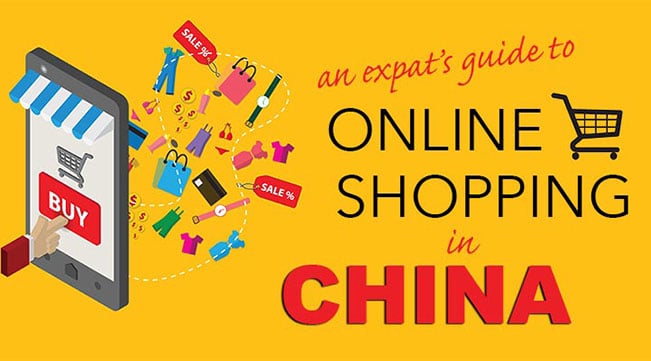
When I first moved to China, I remember it being a challenge to find the most simple things like blankets, plates, utensils, cups and anything else needed to make my apartment a home.
From finding a nearby store to identifying quality products at reasonable prices and hauling it back home with a language barrier mixed in, shopping was a struggle.
Fortunately today, online retail outlets like Taobao, Tmall, JD.com, and Amazon China (UPDATE: they’ve now left the market) among others have made shopping in China easy.
Even though the cost of living in China is different based on which city you’re in, online shopping stays the same.
Whether you’re shopping to spruce up your apartment, need new clothes, imported goods, some good Chinese liquor, snacks or some of the hottest items around, shopping online can bring a great deal of savings and convenience to your life in China.
You have to walk before you can crawl, though, and before you can become an expert at online shopping in China, you first need to follow these three steps:
Step 1: Set Up Online Payment in China for Shopping
Let’s start with the most important thing first: if you’d like to buy things online in China, naturally you need to be able to pay for them.
The easiest way to do so is by having a personal bank account with a Chinese bank.
None of the major online marketplaces in China accept Visa, Mastercard or American Express, so it’s almost required that you open a Chinese bank account where you’ll be given a UnionPay debit card (almost…continue reading for more).
If you don’t have the ability or time to open a Chinese bank account, there is one more option known as ECARD (note: this is only for U.S. residents…and it’s currently paused during the Covid pandemic, unfortunately).
The ECARD is the only way I know outside of opening a domestic account to get a UnionPay-branded card. If this sounds interest to you, read about my experience with ECARD here.
For those opening a Chinese bank account, there’s still more you have to do before you start your online shopping spree, though.
For starters, check with your Chinese bank to ensure online payments is enabled on your account. Otherwise, you will not be able to make any online purchases.
To enable online payments, go into your local bank and say or show to the banker, “开网上支付功能 (Kāi wǎngshàng zhīfù gōngnéng).”
Once online payments has been enabled, you can use your bank card to purchase products on any e-commerce website in China.
Tip: Use AliPay or WeChat to Pay Online in China
For an extra layer of security when paying for items online in China, use Alipay or WeChat when checking-out.
When using mobile payment solutions, payment is deducted during check-out and not transferred into the sellers account until after you certify you have received the product and want to proceed with payment. If you are not pleased with the product, you can easily get the money transferred back into your bank account.
Unfortunately, you can’t use WeChat or Alipay without first opening a Chinese bank account.
To link your bank account to Alipay or WeChat, download the app onto your phone and follow the prompts to register. Once on the main screen, click on the pocket option on the top right.
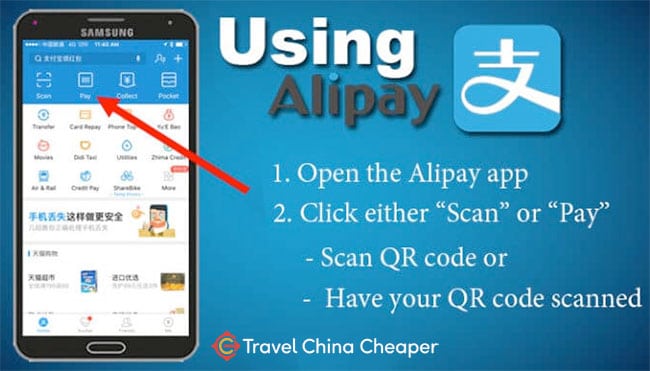
From there, you can add your bank card information under the field with the credit card icon. After linking your bank card to your account, you can start your online shopping in China using your Alipay to purchase items online.
Step 2: Arranging Package Delivery in China
Having items delivered to you in China isn’t difficult, but it a lot does depend on where you are.
For example, If you live on a school campus, check-in with your school administrator about how to list your address and where packages are delivered. Most likely there is a school employee whose job it is to receive packages on behalf of staff members on your school campus.
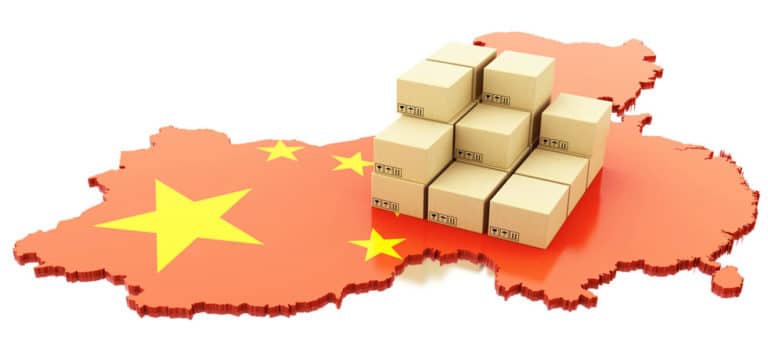
However, if you live in a community apartment, it may make sense to list your employer’s location as the delivery address. Delivery in China is not similar to Western countries where packages are simply left at your door.
Deliveries in China are not left at your door – there must be somebody present to accept the package.
To ensure delivery, the courier usually calls you prior to delivery to ensure you are home. If you are not available, they will suggest an alternative time to make the delivery to ensure the package does not end up in the wrong hands or lost.
If you speak a decent level of Chinese, most likely you can handle arranging delivery over the phone.
If not (and why not try to learn Chinese since you live in China?!), list your employer as the primary address so you can easily pick it up from whomever manages the mail.
When receiving packages in person, it is a good idea to open them up and ensure they are in good quality condition. If not satisfied, you can let the courier know you do not want it and they will return it to the sender.
If after delivery has been made you want to make a return, you need to follow the return process on the e-commerce website where you made the purchase.
This also includes reaching out to the local express delivery courier (快递公司 / kuadi gonsii) to arrange a pick-up to return your package.
Pro Tip: It is possible to have packages delivered to hotels if you’re traveling. Make sure you call the hotel prior to the package arrival so that they know to expect it.
Step 3: Choose Your Online China Marketplace
Now that you have payment set up and know where you’ll have the package(s) delivered, it’s time to start browsing the different marketplaces where you’ll be doing your online shopping in China.
Now that Amazon officially exited the China market in 2019, here’s what’s available to you along with the pros and cons of each:
| Online Shopping Website | Pros | Cons |
| Taobao | Over 800 million product listings – more than any other platform in China | Many counterfeit products and easy to be duped into buying fakes |
| Can directly connect with seller on Alibaba’s Aliwangwang app | ||
| TMall | No counterfeit goods as all sellers must provide documents of authenticity prior to opening up shop on TMall | Smaller selection than Taobao |
| Can also directly connect with seller on Alibaba’s Aliwangwang app | ||
| JD.com | Fast shipping times due to JD.com owning its own network of warehouses and delivery and pickup stations. | Cannot directly connect with sellers like you can on Taobao and TMall |
Now, let’s take a moment to dive deeper into each of these online shopping platforms in China.
1. Taobao – China’s Largest Marketplace
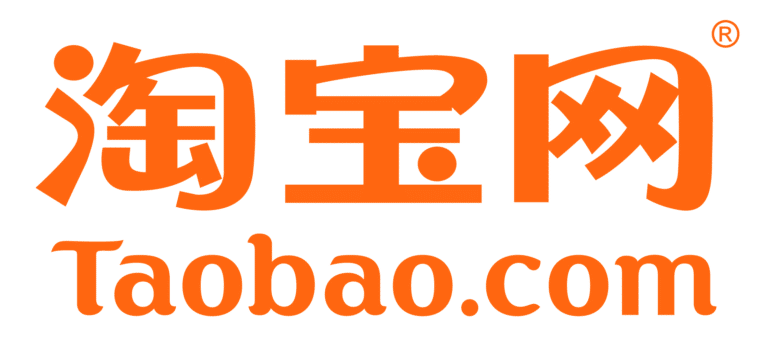
Founded by famous Chinese entrepreneur Jack Ma and Alibaba Group in 2003, Taobao is the largest e-commerce marketplace in China.
As a consumer-to-consumer (C2C) website, Taobao allows businesses and individual entrepreneurs to sell on the platform.
The biggest appeal with Taobao is the large volume of sellers. With over 800 million product listings, you are bound to find anything you need at a reasonable price.
Additionally, consumers can always look forward to November 11th, known as “singles day” or locally as “shuang shiyi”, where you can purchase heavily discounted merchandise as part of the world’s largest shopping extravaganza.
Yet with high volumes of sellers, Taobao is rampant with large numbers of counterfeit goods sold on the marketplace. Although Alibaba is currently taking measures to reduce fakes on Taobao, your best way to avoid counterfeit goods is to review seller ratings along with customer feedback found at the bottom of the product posting page.
If you cannot read Chinese, Google Translate can do the trick in helping you determine the good sellers from the bad. In the end, if a post looks too good to be true, it most likely is.
2. TMall – Great for Imported Goods

Also owned by Alibaba, Tmall was launched as a business-to-consumer (B2C) platform. Unlike Taobao, TMall’s B2C model restricts sellers to official manufacturers or registered brands.
In addition, prior to opening a shop on Tmall, sellers need to provide documentation to confirm the authenticity of the company, manufacturer, or brand.
Under this model, consumers are better protected from counterfeit goods and can rest easy knowing that everything sold on the platform is genuine and delivered directly from the manufacturer or brand.
To date, TMall has over 70,000 official stores and features many foreign brands making it a good platform for purchasing imported goods.
Some of the top-selling imported products include cosmetics and hygiene, diapers, ice cream, and even apples and cherries. Furthermore, like Taobao, you can also look forward to huge discounts on the website during shuang shiyi.
3. JD.com – Fastest Shipping Options

JD.com or “JingDong”, has a business model similar to Amazon where it operates as a retailer while simultaneously allowing 3rd Party sellers to do business on the platform. Taobao and TMall, on the other hand, are strictly online marketplaces.
Like its competitors, you can find products of all types on the JD.com website and there are increasing numbers of imported goods available for purchase. You are also likely to get great bargains on electronics, as JD.com often features promotions on electronic goods.
In terms of how JD.com differentiates itself from the competition, the platform is unparalleled in quick shipping options. Some areas in China even offer 3 hour and night delivery options.
With a network of over 60 warehouses across the country and nearly 1,000 delivery stations and 300 pickup stations, you are always likely to receive our products quickly after purchase.
Depending on the seller, you can also pay for goods at the time of ordering online or wait until delivery. Similar to TMall, all goods are also guaranteed by JD.com thus limiting customer concerns for purchasing counterfeit products.
4. [CLOSED] Amazon China – Familiar for Foreigners

In April of 2019, Amazon announced that they were going to be slowly exiting the China market. While they’ve never had a large market share, they’re an excellent example of how China bullies foreign competition. If a company like Amazon can’t survive in China, how do smaller businesses stand a chance?
The advantage of Amazon was the ability to purchase with a foreign credit card, but now that this is no longer available, you’re stuck using a UnionPay card on one of the other Chinese online shopping platforms.
That being said, having an Amazon Prime membership can still be useful in China, as I’ve learned as an expat. Not only can I listen to music and watch shows, I can also shop for my family and friends back home for holidays and birthdays.
Learn more about using Amazon services in China even if Amazon doesn’t serve the China market directly.
Final Thoughts – Online Shopping in China
Shopping online on any of China’s e-commerce websites is bound to make your life in China a great deal more comfortable.
While there are pros and cons to each online platform, a lot of what will determine which website to shop on depends on your own personal tastes.
Try ordering a mix of items from each website to decide which online marketplace you like best and be sure to share your experience with others.
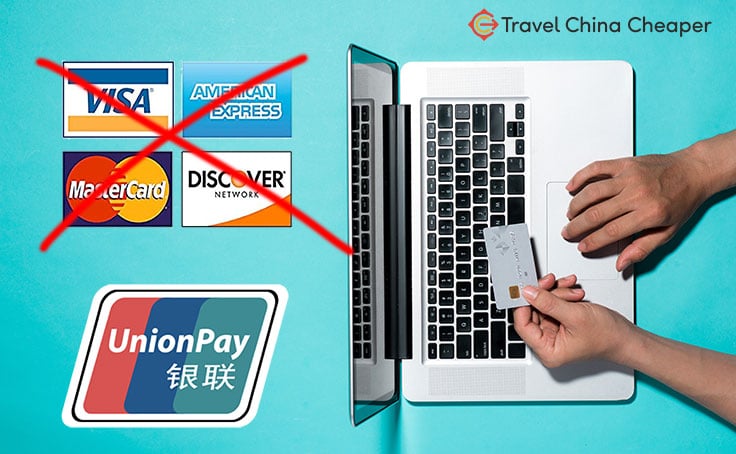







Pandaboo or baopals offer online shopping, in English, payable with us credit cards. I’ve used pandaboo for over a year rather regularly and found it to be very user friendly with excellent customer service.